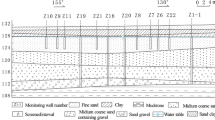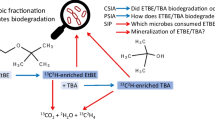Abstract
The contamination of soil and groundwater by the accidental release of petroleum hydrocarbons is a common problem that affects drinking water supplies, and in situ biodegradation is a promising option for removing contaminants, with relatively low costs and minimal health risks. Total petroleum hydrocarbons (TPH), δ13C and 14C isotope ratios in dissolved inorganic carbon (DIC), and other geochemical indicators have been analyzed to demonstrate the effectiveness of in situ biodegradation at a contaminated site. The δ13C and 14C isotope ratios ranged from −5.4 to −18.4 ‰ and from 35.1 to 67 pmc, respectively. Some groundwater samples were contaminated with petroleum hydrocarbons with low 14C and δ13C contents, indicating the existence of microbial non-methanogenic biodegradation, whereas low 14C and high δ 13C contents were associated with the highest TPH concentrations, confirming that microbial methanogenic biodegradation occurred in these areas. Differences in the δ13C and 14C isotope ratios between monitoring wells in uncontaminated and contaminated areas suggest that the percentage of the DIC produced by methanogenic biodegradation decreased from 28.5–32.0 to 5.94–6.67 % along the flow direction, and became almost zero in downgradient areas and at the edge of the contamination plume.





Similar content being viewed by others
References
Aelion CM, Kirtland BC, Stone PA (1997) Radiocarbon assessment of aerobic petroleum bioremediation in the vadose zone and groundwater at an AS/SVE site. Environ Sci Technol 3112:3363–3370
Aggarwal PK, Hinchee RE (1991) Monitoring in situ biodegradation of hydrocarbons by using stable carbon isotopes. Environ Sci Technol 25:1178–1180
Anderson RT, Lovley DR (1997) Ecology and biogeochemistry of in situ groundwater bioremediation. Adv Microb Ecol 15:289–350
Baedecker MJ, Cozzarelli IM, Eganhouse RP, Siegel DI, Bennett PC (1993) Crude oil in a shallow sand and gravel aquifer-III. Biogeochemical reactions and mass balance modeling in anoxic groundwater. Appl Geochem 8:569–586
Bauer JE, Spies RB, Vogel JS, Nelson DE, Southon JR (1990) Radiocarbon evidence of fossil-carbon cycling in sediments of a nearshore hydrocarbon seep. Nature 348:230–232
Bauer JE, Williams PM, Druffel ERM (1992) 14C activity of dissolved organic carbon fractions in the north-central Pacific and Sargasso Sea. Nature 357:667–670
Bauer JE, Reimers CE, Druffel ERM, Williams PM (1995) Isotopic constraints on carbon exchange between deep ocean sediments and sea water. Nature 373:686–689
Bhupathiraju VK, Krauter P, Holman HYN, Conrad ME, Daley PF, Templeton AS, Hunt JR, Hernandez M, Alvarez-Cohen L (2002) Assessment of in situ bioremediation at a refinery waste-contaminated site and an aviation gasoline contaminated site. Biodegradation 13:79–90
Bolliger C, Höhener P, Hunkeler D (1999) Intrinsic bioremediation of a petroleum hydrocarbon-contaminated aquifer and assessment of mineralization based on stable carbon isotopes. Biodegradation 10:201–217
Borden RC, Gomez CA, Becker MT (1995) Geochemical indicators of intrinsic bioremediation. Ground Water 33(2):180–189
Bugna GC, Chantona JP, Stauffer TB, MacIntyre WG, Libelo EL (2005) Partitioning microbial respiration between jet fuel and native organic matter in an organic-rich long time-contaminated aquifer. Chemosphere 60:177–187
Cerling TE, Solomon DK, Quade J, Bowman JR (1991) On the isotopic composition of carbon in soil carbon dioxide. Geochim Cosmochim Acta 55:3403–3405
Clark I, Fritz P (1997) Environmental isotopes in hydrogeology. CRC press, New York
Coffin RB, Pohlman JW, Grabowski KS, Knies DL, Plummer RE, Magee RW, Boyd TJ (2008) Radiocarbon and stable carbon isotope analysis to confirm petroleum natural attenuation in the vadose zone. Environ Forensics 9:75–84
Conrad ME, Depaolo DJ (2004) Carbon isotopic evidence for biodegradation of organic contaminants in the shallow vadose zone of the radioactive waste management complex. Vadose Zone J 3:143–153
Conrad ME, Daley PF, Fischer ML, Buchanan BB, Leighton T, Kashgarian M (1997) Combined 14C and 13C monitoring of in situ biodegradation of petroleum hydrocarbons. Environ Sci Technol 31:1463–1469
Conrad ME, Templeton AS, Daley PF, Cohen LA (1999) Isotopic evidence for biological controls on migration of petroleum hydrocarbons. Org Geochem 30:843–859
Dong WH, Zhang Y, Lin XY, Du SH (2014) Prediction of 1,2,4-trichlorobenzene natural attenuation in groundwater at a landfill in Kaifeng, China. Environ Earth Sci 71:941–948
Douglas GS, McCarthy JK, Dahlen DT, Seavey JA, Steinhauer WG, Prince RC, Elmendorf DL (1992) The use of hydrocarbon analyses for environmental assessment and remediation. J Soil Contam 1:197–216
Fang J, Barcelona MJ, Krishnamurthy RV (2000) Stable carbon isotope biogeochemistry of a shallow sand aquifer contaminated with fuel hydrocarbons. Appl Geochem 15:157–169
Fleming JT, Sanseverino J, Sayler GS (1993) Quantitative relationship between catabolic gene frequency and expression in predicting PAH degradation in soils at town gas manufactured sites. Environ Sci Technol 27:1068–1074
Hunkeler D, Hǒhener P, Bernasconi S (1999) Engineered in situ bioremediation of a petroleum hydrocarbon-contaminated aquifer: assessment of mineralization based on alkalinity, inorganic carbon and stable isotope balances. J Contam Hydrol 37:201–233
Kao CM, Wang YS (2001) Field investigation of the natural attenuation and intrinsic biodegradation rates at an underground storage tank site. Environ Geol 40(4–5):622–631
Krishnamurthy RV, Atekwana EA, Guha H (1997) A simple, inexpensive carbonate–phosphoric acid reaction method for the analysis of carbon and oxygen isotopes of carbonates. Anal Chem 69(20):4256–4258
Landmeyer JE, Vroblesky DA, Chapelle FH (1996) Stable carbon isotope evidence of biodegradation zonation in a shallow jet-fuel contaminated aquifer. Environ Sci Technol 30:1120–1128
Lesage S, Hao X, Kent SN (1997) Distinguishing natural hydrocarbons from anthropogenic contamination in groundwater. Groundwater 35(1):149–160
Libby WF (1955) Radiocarbon dating, 2nd edn. University of Chicago Press, Chicago
Lollar BS, Slater GF, Sleep B (2001) Stable carbon isotope evidence for intrinsic bioremediation of tetrachloroethene and trichloroethene at area 6, Dover Air Force Base. Environ Sci Technol 352:261–269
Loyd DH, Vogel JS, Trumbore S (1991) Lithium contamination in AMS measurements of C-14. Radiocarbon 33:297–301
Madsen EL, Sinclair JL, Ghiorse WC (1991) In situ biodegradation: microbiological patterns in a contaminated aquifer. Science 252:830–833
National Research Council (1993) In situ Bioremediation when does it work?. National Academy Press, Washington, DC
Revesz K, Coplen TB, Baedecker MJ, Glynn PD (1995) Hult M. Methane production and consumption monitored by stable H and C isotope ratios at a crude oil spill site, Bemidji, Minnesota. Appl Geochem 10:505–516
Schoell M (1984) Stable isotopes in petroleum research. Adv Petroleum Geochem 1:215–245
Su XS, Lv H, Zhang WJ, Zhang YL, Jiao X (2013) Evaluation of petroleum hydrocarbon biodegradation in shallow groundwater by hydrogeochemical indicators and C, S-isotopes. Environ Earth Sci 69(6):2091–2101
Suchomel KH, Kreamer DK, Long A (1990) Production and transport of carbon dioxide in a contaminated vadose zone: a stable and radioactive carbon isotope study. Environ Sci Technol 24:1824–1831
Topinkova B, Nesetril K, Datel J (2007) Geochemical heterogeneity and isotope geochemistry of natural attenuation processes in a gasoline-contaminated aquifer at the Hnevice site, Czech Republic. Hydrogeol J 15:961–976
Author information
Authors and Affiliations
Corresponding author
Rights and permissions
About this article
Cite this article
Lv, H., Wang, Y., Su, X. et al. Combined 14C and δ13C analysis of petroleum biodegradation in a shallow contaminated aquifer. Environ Earth Sci 74, 431–438 (2015). https://doi.org/10.1007/s12665-015-4049-8
Received:
Accepted:
Published:
Issue Date:
DOI: https://doi.org/10.1007/s12665-015-4049-8




